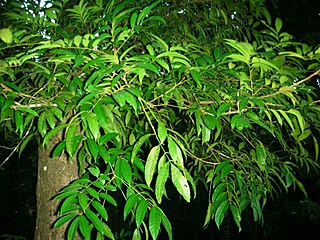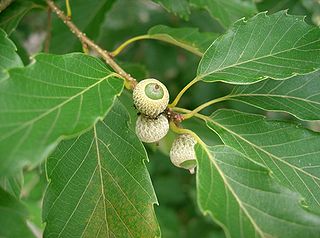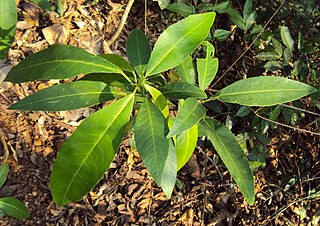
Alders are trees that compose the genus Alnus in the birch family Betulaceae. The genus includes about 35 species of monoecious trees and shrubs, a few reaching a large size, distributed throughout the north temperate zone with a few species extending into Central America, as well as the northern and southern Andes.

Coriaria is the sole genus in the family Coriariaceae, which was described by Linnaeus in 1753. It includes 14 species of small trees, shrubs and subshrubs, with a widespread but disjunct distribution across warm temperate regions of the world, occurring as far apart as the Mediterranean region, southern and eastern Asia, New Zealand, the Pacific Ocean islands, and Central and South America.

Quercus acutissima, the sawtooth oak, is an Asian species of oak native to China, Tibet, Korea, Japan, Indochina and the Himalayas. It is widely planted in many lands and has become naturalized in parts of North America.

Taxus wallichiana, the Himalayan yew, is a species of yew, native to the Himalaya and parts of south-east Asia. The species has a variety of uses in traditional medicine. It is currently classified as endangered by the IUCN.

Aglaia lawii is a species of tree in the family Meliaceae. As well as the autonym species, there are two subspecies accepted.

Aglaia spectabilis is a species of tree in the family Meliaceae, found from the Santa Cruz Islands in the southwest Pacific to Queensland (Australia), Southeast Asia, Yunnan (Zhōngguó/China) and the Indian subcontinent. It grows from a 1m shrub to an emergent 40m tall tree, depending on the habitat. Its wood is commercially exploited as timber, but otherwise is of poor quality with limited use. The fruit are eaten, and used in folk medicine. The seeds are large in comparison to other plants, and a major source of dispersal of the species are hornbills eating the fruit, flying away from the tree and regurgitating the seeds.It is also found in Assam, India

Campylospermum serratum is a plant in the family Ochnaceae. The specific epithet serratum is from the Latin meaning "with teeth", referring to the leaf margin. It is found in Tropical Asia, from Sulawesi, Indonesia to Hainan, Zhōngguó/China and over to southwestern India. Gomphia serrata was a previous common name for the species. The plant is used for it wood and its sap is used in folk medicine and in the past for teeth-blackening.

Barleria prionitis is a shrub in the family Acanthaceae, native to Island and Mainland Southeast Asia, China, the Indian Subcontinent, the Arabian Peninsula and northeastern Africa. It is widely spread as an ornamental and weed, occurring in naturalised populations around the world. It used not only as an ornamental but also as a hedge and extensively as a component of folk medicines. As a weed it is regarded as problematic in many areas.

Elaeocarpus lanceifolius is a tree species in the family Elaeocarpaceae. It is found across tropical Asia from Thailand to Yunnan to Nepal to Karnataka, India. It is used for its wood, fruit, and nuts.

Dioscorea pentaphylla is a species of flowering plant in the yam family known by the common name fiveleaf yam. It is native to southern and eastern Asia as well as New Guinea, Sri Lanka and northern Australia. It is widely cultivated as a food crop and naturalized in Cuba and on several island chains in the Pacific.

Alnus alnobetula is a common tree widespread across much of Europe, Asia, and North America. Many sources refer to it as Alnus viridis, the green alder, but botanically this is considered an illegitimate name synonymous with Alnus alnobetula subsp. fruticosa.

Quercus serrata, the jolcham oak, is an East Asian species of tree in the beech family. It is native to China, Taiwan, Japan, and Korea.
Acer caesium, the Himalayan maple, is an Asian species of maple found in India, Pakistan, Nepal, and China.
Plants of the World Online (POWO) is an online database published by the Royal Botanic Gardens, Kew. It was launched in March 2017 with the ultimate aim being "to enable users to access information on all the world's known seed-bearing plants by 2020". This was Kew's answer to the "2020 target 1" of the Convention on Biological Diversity (CBD): "an online flora for all known plants."

The dog teak or Nepali elephant apple is a small tree with tortuous twigs, Dillenia pentagyna is a member of the family Dilleniaceae, and is found from Sulawesi to South-Central China to India and Sri Lanka. Material from the tree has some minor uses.
Neonauclea sessilifolia is a tree species in the Rubiaceae family. It is found in Taiwan, and then from Yunnan, Zhōngguó/China, to Southeast Asia and northeastern India.
Strychnos nux-blanda is a shrub or small tree in the Loganiaceae family. It is native to Southeast Asia and Assam. The wood is used as fuel; seeds are toxic, but used in folk-medicine. It is one of the plants featured in the garden of King Narai (1633–88) at Lopburi, Thailand.
Syzygium apodophyllum is a tree in the Myrtaceae family endemic to north Queensland. The fruit is edible. It is a host for the exotic plant-pathogen fungus Austropuccinia psidii, which is causing a lot of damage to vegetation communities and economic plants.
Aporosa villosa is a species of shrub or small tree in the family Phyllanthaceae. It is found in Southeast Asia, including the Nicobar, Andaman and Paracel Islands. There are some traditional medicinal uses for plant, particularly around care after childbirth. The shrub is often a pioneer species, tolerant of full sun, but intolerant of frequent fires.

Croton persimilis is a species of tree in the Euphorbiaceae family. It is native to an area from Thailand in mainland Southeast Asia to southern Yunnan, China and to the Indian subcontinent. It is a pioneer species with a short life span. The plant is used in the traditional medicines of various peoples.


















